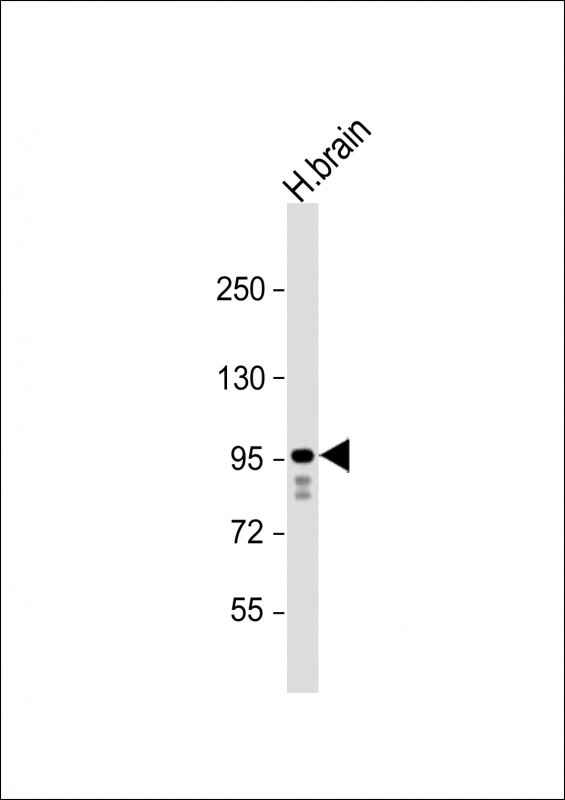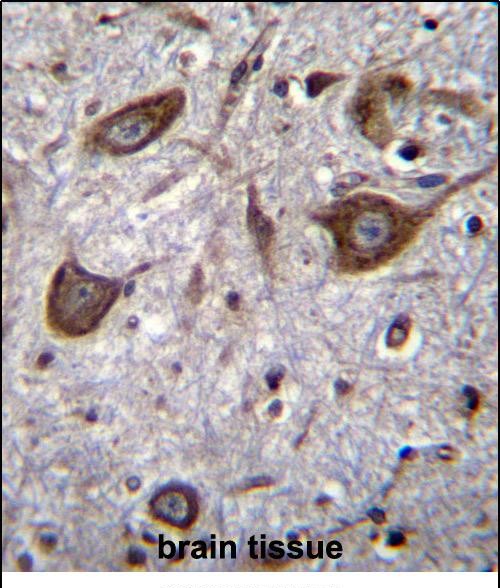GRIA4 Antibody (Center)
Affinity Purified Rabbit Polyclonal Antibody (Pab)
- SPECIFICATION
- CITATIONS: 1
- PROTOCOLS
- BACKGROUND

Application
| IHC-P, WB, E |
|---|---|
| Primary Accession | P48058 |
| Other Accession | P19493, Q9Z2W8, Q38PU5, NP_000820.3 |
| Reactivity | Human, Mouse |
| Predicted | Monkey, Rat |
| Host | Rabbit |
| Clonality | Polyclonal |
| Isotype | Rabbit IgG |
| Calculated MW | 100871 Da |
| Antigen Region | 296-325 aa |
| Gene ID | 2893 |
|---|---|
| Other Names | Glutamate receptor 4, GluR-4, GluR4, AMPA-selective glutamate receptor 4, GluR-D, Glutamate receptor ionotropic, AMPA 4, GluA4, GRIA4, GLUR4 |
| Target/Specificity | This GRIA4 antibody is generated from rabbits immunized with a KLH conjugated synthetic peptide between 296-325 amino acids from the Central region of human GRIA4. |
| Dilution | IHC-P~~1:10~50 WB~~1:1000 E~~Use at an assay dependent concentration. |
| Format | Purified polyclonal antibody supplied in PBS with 0.09% (W/V) sodium azide. This antibody is purified through a protein A column, followed by peptide affinity purification. |
| Storage | Maintain refrigerated at 2-8°C for up to 2 weeks. For long term storage store at -20°C in small aliquots to prevent freeze-thaw cycles. |
| Precautions | GRIA4 Antibody (Center) is for research use only and not for use in diagnostic or therapeutic procedures. |
| Name | GRIA4 {ECO:0000303|PubMed:29220673, ECO:0000312|HGNC:HGNC:4574} |
|---|---|
| Function | Ionotropic glutamate receptor that functions as a ligand- gated cation channel, gated by L-glutamate and glutamatergic agonists such as alpha-amino-3-hydroxy-5-methyl-4-isoxazolepropionic acid (AMPA), quisqualic acid, and kainic acid (By similarity). L-glutamate acts as an excitatory neurotransmitter at many synapses in the central nervous system and plays an important role in fast excitatory synaptic transmission (By similarity). Binding of the excitatory neurotransmitter L-glutamate induces a conformation change, leading to the opening of the cation channel, and thereby converts the chemical signal to an electrical impulse upon entry of monovalent and divalent cations such as sodium and calcium. The receptor then desensitizes rapidly and enters a transient inactive state, characterized by the presence of bound agonist (By similarity). In the presence of CACNG8, shows resensitization which is characterized by a delayed accumulation of current flux upon continued application of L-glutamate (PubMed:21172611). |
| Cellular Location | Cell membrane {ECO:0000250|UniProtKB:P19493}; Multi-pass membrane protein {ECO:0000250|UniProtKB:P19493} Postsynaptic cell membrane {ECO:0000250|UniProtKB:P19493}; Multi-pass membrane protein {ECO:0000250|UniProtKB:P19493}. Cell projection, dendrite {ECO:0000250|UniProtKB:P19493}. Postsynaptic cell membrane {ECO:0000250|UniProtKB:P42262}; Multi-pass membrane protein {ECO:0000250|UniProtKB:P42262} |

Provided below are standard protocols that you may find useful for product applications.
Background
Glutamate receptors are the predominant excitatory neurotransmitter receptors in the mammalian brain and are activated in a variety of normal neurophysiologic processes. These receptors are heteromeric protein complexes composed of multiple subunits, arranged to form ligand-gated ion channels. The classification of glutamate receptors is based on their activation by different pharmacologic agonists. The subunit encoded by this gene belongs to a family of AMPA (alpha-amino-3-hydroxy-5-methyl-4-isoxazole propionate)-sensitive glutamate receptors, and is subject to RNA editing (AGA->GGA; R->G). Alternative splicing of this gene results in transcript variants encoding different isoforms, which may vary in their signal transduction properties. Some haplotypes of this gene show a positive association with schizophrenia. [provided by RefSeq].
References
Need, A.C., et al. Eur. J. Hum. Genet. 17(7):946-957(2009)
Volpi, S., et al. J Clin Psychiatry 70(6):801-809(2009)
Kessels, H.W., et al. Neuron 61(3):340-350(2009)
Arai, S., et al. Psychiatr. Genet. 19(1):6-13(2009)
Aruscavage, P.J., et al. RNA 6(2):257-269(2000)
If you have used an Abcepta product and would like to share how it has performed, please click on the "Submit Review" button and provide the requested information. Our staff will examine and post your review and contact you if needed.
If you have any additional inquiries please email technical services at tech@abcepta.com.














 Foundational characteristics of cancer include proliferation, angiogenesis, migration, evasion of apoptosis, and cellular immortality. Find key markers for these cellular processes and antibodies to detect them.
Foundational characteristics of cancer include proliferation, angiogenesis, migration, evasion of apoptosis, and cellular immortality. Find key markers for these cellular processes and antibodies to detect them. The SUMOplot™ Analysis Program predicts and scores sumoylation sites in your protein. SUMOylation is a post-translational modification involved in various cellular processes, such as nuclear-cytosolic transport, transcriptional regulation, apoptosis, protein stability, response to stress, and progression through the cell cycle.
The SUMOplot™ Analysis Program predicts and scores sumoylation sites in your protein. SUMOylation is a post-translational modification involved in various cellular processes, such as nuclear-cytosolic transport, transcriptional regulation, apoptosis, protein stability, response to stress, and progression through the cell cycle. The Autophagy Receptor Motif Plotter predicts and scores autophagy receptor binding sites in your protein. Identifying proteins connected to this pathway is critical to understanding the role of autophagy in physiological as well as pathological processes such as development, differentiation, neurodegenerative diseases, stress, infection, and cancer.
The Autophagy Receptor Motif Plotter predicts and scores autophagy receptor binding sites in your protein. Identifying proteins connected to this pathway is critical to understanding the role of autophagy in physiological as well as pathological processes such as development, differentiation, neurodegenerative diseases, stress, infection, and cancer.



